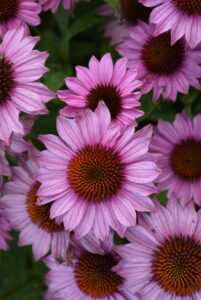After three seasons growing in the challenging conditions of the Rocky Mountains, seven perennial plants have been named “Top Performers” by researchers at Colorado State University.
Evaluating Perennials in the Rocky Mountains
The purpose of the trial garden is to evaluate new plant species and cultivars under the unique Rocky Mountain environmental conditions. Plants are evaluated for plant vigor, uniformity, floriferousness and tolerance to environmental and biotic stresses. The Perennial Trial program at CSU is designed to test newer perennial cultivars that have been introduced in the past three years or less. Entries in this trial are grown for three summers and two winters before they are switched out for new entries.
2023 CSU “Top Performer” Perennials

Brunnera ‘Alexandria’ TERRA NOVA® Nurseries
Beautiful silver, cordate leaves were very attractive all growing season creating dependable, bright spot of color in shady areas. Foliage was described as having less veining and were relatively thick giving it substance and creating a strong mat of silver leaves, great for contrasting with other plants, like darker leaved heucheras. During the early summer a delicate cloud of blue flowers creates a unique look in the garden.
Enchinacea ‘SunMagic Vintage Fuschia’
Flamingo Holland / Bull Breeding
This coneflower was noted for their impressive ‘flower power’, providing showstopping color for two solid months. The attractive flowers were a bright and intense fuschia-pink color, with the ray flowers being held horizontal topped with an intensely colored big “Hershey Kiss cone on top”. The darker cone and dark stems made a great contrast with the bright blooms. Plants had a very uniform growth habit and showed great winter survival.
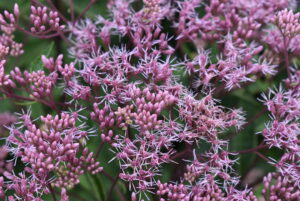 Eupatorium ‘Little-Pye’
Eupatorium ‘Little-Pye’
Dümmen Orange
“Little” is somewhat relative with this native plant! Really, only in the first year, expect this plant to be ‘little’ and short at just over a foot tall. However, once established in the garden, one should expect ‘Little-Pye’ to grow to make a statement in the garden, reaching upwards of 6 feet tall. So, we wouldn’t recommend putting this in the front of the border…place it somewhere where it can fill out and reach for the sky. ‘Little-Pye’ makes for a beautiful show in late summer landscape, with blooms covering the canopy at its peak. And the inflorescences remained attractive after flowering, offering winter interest or potential use as a dried flower. Plants were very uniform with strong stems that held the impressive inflorescences from lodging. There was no evidence of any disease or insect problems. All this combined, makes the case for this plant being a low maintenance garden plant. Oh… and not to forget, this was a bee-magnet…They loved it!
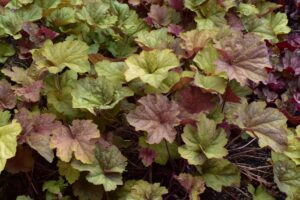 Heuchera ‘Big Top Caramel Apple’
Heuchera ‘Big Top Caramel Apple’
Darwin Perennials
Who doesn’t like caramel apples?! This coral bell lives up to its name. The foliage changes color, as it matures through the season, providing early shades of green, almost Granny Smith Apple green, to hints of red and ultimately, overtones of caramel. Interest is also created with contrasting colors on the underside of the leaf which is a distinct burgundy color. Plants are vigorous and relatively large creating a big canopy hence the name. Small flowers gave it a more naturalized appearance great for use in a woodland garden. Winter survival was perfect after two Colorado winters. Are you hungry for this plant yet?
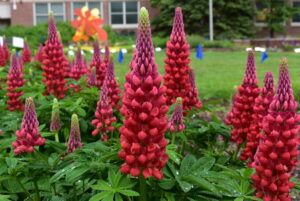 Lupinus x ‘Beefeater’
Lupinus x ‘Beefeater’
Gulley Greenhouse and Eason Horticulture Resources
Just like the guards at the Tower of London, you can’t miss the vibrant colors of this garden classic. The intense, vibrant cherry red color that holds up well in the sun with no fading, along with the large spires easily make this a “Wow” plant from across the garden! The sheer number of blooms set this apart from other lupines and the flower stems were sturdy, without any lodging over the flowering periods. This selection bloomed more profusely in full sun. Don’t miss out on this one.
 Phlox paniculata ‘Ka-Pow® Soft Pink’
Phlox paniculata ‘Ka-Pow® Soft Pink’
Darwin Perennials
Can one have a perennial border without a phlox? Here’s another great, reliable performer from the ‘Ka-Pow®’ series. Other selections from the series have been note for their flower power and ‘Soft Pink’ was no different. The flower panicles covered the foliage with a beautiful canopy of medium soft pink florets with a deeper pink eye, creating an impressive display with a long bloom season. The less than two-foot-tall plants had excellent branching without any pinching necessary. This selection also proved to be very resistant to powdery mildew. If you want to pack a punch in your perennial border, certainly consider ‘Ka-Pow® Soft Pink’!
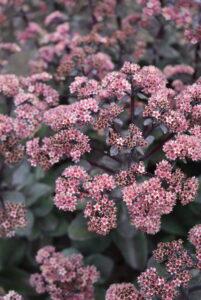 Sedum ‘Rock ‘N Grow® Back in Black’
Sedum ‘Rock ‘N Grow® Back in Black’
Proven Winners® and Walters Gardens
Crank up the volume with this sedum. The foliage on this sedum is so dark at times, it almost appears black. That dark foliage makes for a great contrast to the late summer, deep red and cream flower heads. This is a great resource for sustaining pollinators late in the season. The uniform plants are attractive as well as being low maintenance and a good water conserving choice for the western garden. During 2023 it tolerated unusually heavy rains and was adaptable to multiple sites. Use this plant in the border to contrast with the other foliage and flowers in the landscapes. Put some beat into your landscape with ‘Back in Black.”
About the Trial Garden
CSU’s Flower Trial Garden, which draws thousands of visitors each year, relies on student gardeners, volunteers and industry supporters and experts who help provide detailed analysis of plant performance. Colorado State Extension Master Gardeners play an essential role in planting and maintenance of the garden. The outcome of this research is valuable to the industry and home gardeners alike. That’s because the Rocky Mountain region has unique growing conditions, characterized by high altitude, intense solar radiation, drying winds, severe hailstorms, large fluctuations between day and night temperatures and a season-long need for irrigation.
The Perennial Trial Garden receives no direct state or public funding. It is funded primarily by fees from plant-breeding companies that submit entries to the trials. The garden also receives donations from industry associations, foundations, nurseries, plant producers and other companies in the green industry.
Performance Evaluation
Photos and data on plants and flowers were collected on a bi-weekly basis from May to early October. Dead plants in the trial were not considered in the bi-weekly evaluation; thus, the ratings given only reflect the live plants. Members from the Perennial Trial subcommittee also evaluated and wrote comments for each plant variety in June, July, August and September. Plants and flowers were rated 0-5 using the following scale:
0 = Dead/No flowers
1 = Poor: Plants are very sick or dying, extremely few flowers
2 = Below Average: Plants are unattractive in some form, i.e. – leggy growth habit, chlorotic or low vigor, flowers are few and occurring sporadically
3 = Average: Plant appearance with growth characteristics that would be expected for the time of season; flowers would be few but uniform across the plants
4 = Good: Plants look attractive (foliage, growth habit, etc.); flowers are blooming strong and showy
5 = Excellent: Plants are very healthy and uniform; flowering is impressive
The Top Performers are selected based on their overall high ratings after the three years. A special committee of local industry horticulture professionals meet to discuss the results to ensure the best of the best are highlighted from our trials.
